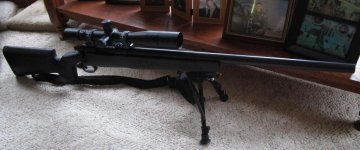I've heard about Model 70's being used as sniper rifles but always thought that they never we given their due. One thing I thing that people overlook is the Model 70's massive flat bottom and all that surface area for bedding.Plus it has 4 screws 3 of which help bedding the rifle. I've a 1966 Model 70 with the old style "Marksman" style stock It's in 30-06 I've chronohraphed the 165 Nosler Ballistic tip at 2800 feet per second…../
It’s somewhat ironic that the changes Winchester made in 1964 were so poorly received when the changes they made (brazed bolt handle, wedge extractor, and enclosed bolt face) brought the Model 70 in line with the Remington Model 700 which had essentially the same features and similar quality.
The controlled feed offered by the Mauser style claw extractor was an advantage with the pre 64 Model 70, as was the smoother bolt travel the design offered.
Winchester added an extended bolt lug and rib to smooth the feeding in 1968 as well as returning to steel bottom metal, and went back to the Mauser style controlled feed extractor the post 1992 Model 70.
FN currently makes the controlled feed Model 70 in two police versions, the Special Police Rifle and Patrol Bolt Rifle models.
——-
One of the reasons Winchester went back to the Mauser style controlled feed action on the Model 70 was the market share they lost to Ruger with its Model 77 and in particular the Model 77 Mk II.
The Model 77 was introduced in 1978 and had the Mauser style extractor which gave a smoother bolt travel. (Not coincidentally, Winchester added it’s anti-bind change in 1968). The Mauser extractor also provided very positive extraction, but wasn’t a true controlled feed design as the bolt face wasn’t open on the bottom so the extractor still snapped over tue rim and was still a push feed design.
In 1991 Ruger introduced the Model 77 MK II which opened up the bottom of the bolt face and made the design a true controlled feed rifle and went back to a Mauser style blade ejector.
That put the heat on Winchester to keep up with the Model 70 CRF in 1992.
Like the Model 70 the Ruger was designed with a large flat receiver bottom. Ruger did it in a manner that allowed all the contact surfaces to lie in the same vertical plane so that stocks could be machine inletted and still offer good bedding for the action. Ruger also designed the forward stock screw so that it engaged the lug at an angle and pulled the receiver back and down into contact with the stock.
Also like the Model 70, Rugers have been largely over looked as precision rifles. That’s in part due to Ruger switching from using Douglas barrels to Wilson barrels in 1974. Ruger started hammer forging its own barrels in 1991-1992, more or less with the introduction of the MK II.
The early 1968-73 Model 77s were quite accurate while accuracy in the 1974-1991 Wilson era Model 77 was spotty. In my experience the Ruger made barrels from 1992 onward have been superb.
But the Ruger Model 77 still suffers from that 1974-91 era of inconsistent barrel quality.
Modern precision shooters place way too much stock in the relative stiffness of the Remington tubular receiver and the “advantages” of short actions, and thus overlook the Winchester and Ruger options and their inherent advantages.

